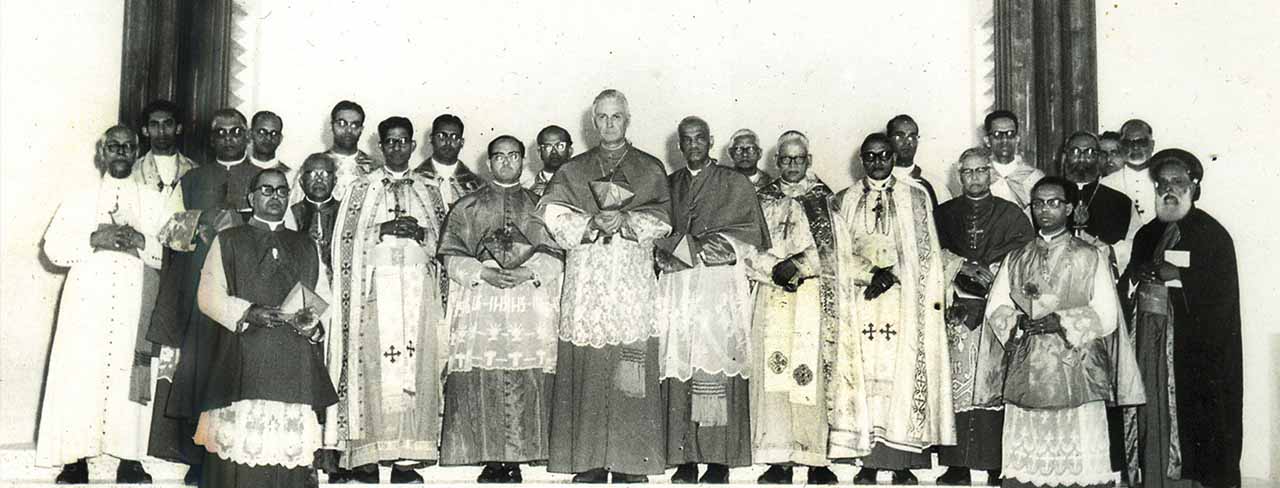

It will be nothing of exaggeration or undervalued self-estimation to call the St. Thomas Apostolic Seminary a twin-born child with the second Vatican Council. As the land-marking Council had its glorious flag-off on the 11th of October 1962, the Seminary for the Oriental Churches in India had its first seminarian to enter into this glorious home of the Syro-Malabar Church on the 31st of May, 1962. It was a dream fulfilled and one yet to achieve. It was a task realized and yet to thrive hard. It was a responsibility handed down and yet to be accomplished. It was the glorious moment of entrusting the great mission of forming the future priests of the Church after the heart of Jesus the Pastor and Guru, the forerunner and role-model for all the generations. Vatican Council was not the daydream of any man on the top! It was God’s plan, the gift of the Holy Spirit to the Church. When Pope John XXIII took his seat on the Chair of Peter, no one thought of a new council.

Neither could it have been in the brain of the ‘Old man walking over the hard stones of the Piaza di San Pietro’. But it became a reality dramatically fast, with its announcement on just ninety days after the Pope’s enthronement! As the Holy Father himself proclaimed on June 5th 1960 through the Apostolic writing Superno Dei Nutu, that was the direct inspiration of the Most High. And in two years, it became a reality. And now, we are on the Golden Jubilee of that Divine Inspiration!
One cannot find any other words in the case of the birth of the Vadavathoor Seminary too. It was God’s gift to the Church. And God made use of many holy and prophetic persons to the realization of that project. And there begins the story and the history of the St. Thomas Apostolic Seminary at Vadavathoor, Kottayam. Before we name out and trace back the persons and events attached to the beginning of this Seminary, it would be reasonable to look into the ratio of this great institution.The Council clearly states in its Decree on the Priestly Formation the orientations of the Major Seminaries. It states: “Major seminaries are necessary for priestly training. In them the whole training of the students should have as its object to make them true shepherds of souls after the example of our Lord Jesus Christ, teacher, priest and shepherd. Hence, they should be trained for the ministry of theWord, so that they may gain an ever increasing understanding of the revealed Word of God, making it their own by meditation, and giving it expression in their speech and in their lives.
They should be trained for the ministry of worship and sanctification so that by prayer and the celebration of the sacred liturgical functions, they may carry on the work of salvation through the Eucharistic sacrifice and the sacraments. They should be trained to undertake the ministry of the shepherd, that they may know how to represent Christ to men, Christ who ‘did not come to have service done to him, but to serve others and to give his life as a ransom…’ ” (OT n.4). This goal of the seminaries is the same whether they are intended to form priests for Religious Orders or for the diocesan pastoral work. It had been taken for granted that it is the duty of the local bishop to take care of the formation of the candidates for priesthood, having diocesan seminaries for one’s own diocese. The council also envisages the possibility and sometimes the necessity to have regional seminaries to give better training (OT n.7).
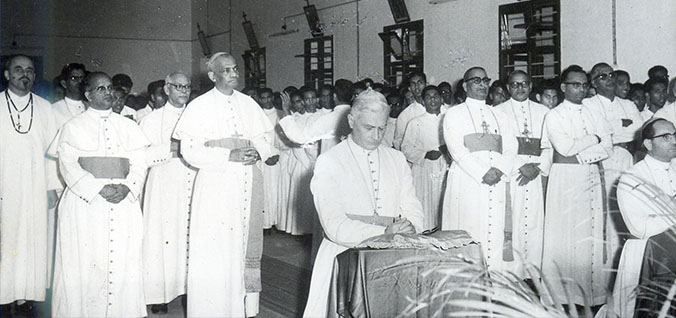
Greater awareness of the Church of the rich heritage of the Oriental Ecclesiastical traditions and the conviction from the part of the ecclesiastical authorities in Rome for the need for an indigenous method of priestly formation in the traditions of the Oriental Churches in India too have naturally accelerated the foundation of an oriental seminary. The establishment of the St. Thomas Apostolic Seminary took place in the above-mentioned contexts and under the new ecclesiological and socio-cultural visions of the Council that had been on its make-up in the years just before the Council.As we notice the long history of the Church of Kerala, it is gratefully acknowledged that priestly formation was effectively done by different persons, first by the elderly priests of high repute, a system later hailed as the “Malpanite”,We are here not to evaluate the ad-vantages or disadvantages of any of these systems, but only to state the historical pre-format of the present seminary. The Carmelite Order under the leadership of the Spanish Missionaries took up the responsibility of the seminary training of the priests of Kerala for about two hundred years.
And it was indeed these missionaries, who as guided by the authorities in Rome, started the project at the second half of the 1950s.
The chief force behind this was Eugine Cardinal Tisserant, the then Prefect of the Sacred Congregation for the Oriental Churches. Tisserant, being a man of great determination, and fascinated by the history of the Oriental Churches in India, took extra pain to establish whatever was necessary for the beginning of the seminary. The enthusiastic efforts of some priests who had been in Rome those years as students and research scholars too had been a great force to this move. To men-tion the champion of this team is the person of Fr. Placid Podipara cmi, the then rector of the College for the Orientals in Rome. Cardinal Tisserant, the secretary of the Congregation for the Oriental Churches from 1936 to 1959 who had an extended knowledge of the Oriental Churches in India through his visit and friendships with the oriental faithful, priests and bishops in Kerala and in Rome is considered to be the executive force behind the foundation of Vadavathoor Seminary. It was under his supervision that the project is prepared and got approved by the Holy See. Immediate steps were taken to buy a plot of land suitable for the construction of the seminary.
Rev. Fr. Victor, the then procurator of the St. Joseph Pontifical Seminary, Alwaye was entrusted with the project of the initial transactions. Eventually, a convenient landscape was found out on the Vadavathoor hills, seven kilometer away from Kottayam, for the future seminary and the property deed was registered on the 22nd of March, 1960. Mar Mathew Kavukat, the then archbishop of the archdiocese of Chenganassery, on his visit to Rome as a member of the Preparatory Commission for the Council was directed by the Oriental Congregation to take over the responsibility of the project. Eventually, Mar Kavukat on 9th April 1961, on the Day of Easter, laid the foundation stone for the seminary building. The construction works went on intensively to say that on the 3rd of July 1962, the seminary was inaugurated with 41 students who joined in the first year of Philosophy. The inauguration was done by Mar Mathew Kavukat himself. The house was blessed by Archbishop (later Cardinal) Joseph Parek katil, bishop of the Archdiocese of Ernakulam. A team of four diocesan priests was the staff of the new seminary.
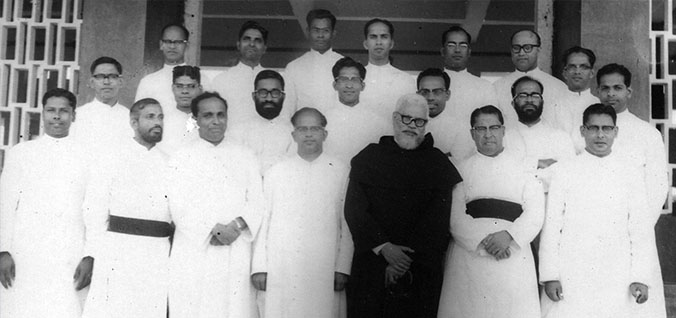
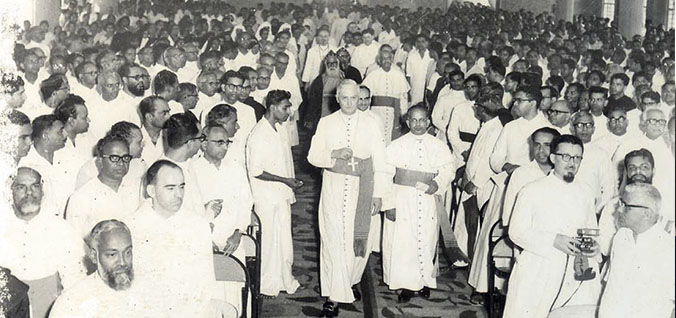
The staff members collectively shared the duties of formation, Very Rev. Fr. Kurian Vanchipurakal from the diocese of Palai as the vice rector, Fr. Louis Neriamparambil from Changanassery as the procurator, Fr. Thomas Nedumpuram from Kothamangalam as the spiritual director and Fr. Joseph Pallikkaparambil from Palai as the teacher of Philosophy. The authorities in Rome have been very particular in appointing only the diocesan priests as the staff,which in fact was necessary for a formation in Theology proper to the diocesan clergy especially according to the spirituality of the diocesan priests. The statutes of the seminary is very keen on this matter and so the same principle is being in force until today. In accordance with this great vision, Fr. Kurian Vanchipurackal is appointed as the first resident rector on 11th Nov. 1964. The rector, being new in the formation of the diocesan priests had no pre-text or road-map in this venture.However, being a man of integrity, determination, planning and more than everything trust in the divine providence had successfully carried out his mission.
As the seminary continues in its 58th year, it has been blessed to have got ordained about 2000 priests in the past years. They are yet in the pastoral fields doing very effective pastoral ministry in Kerala and all over the world. It is of high profile to have some of them as bishops, to mention, Mar George Kocherry (2000), Mar Jacob Angadiath (2001), Mar Mathew Arackal (2001) Mar Joseph Perunthottam (2002), Mar Mathew Anikkuzhikkatil (2003), Mar Joseph Kallarangatt (2004), Mar Ebraham Julios (2008) , Mar Raphel Thattil (2010), Mar Pauly Kannookkadan (2010), Mar Paul Alappat (2010), Mar Remegiose Inchananiyil (2010),Vincent Mar Paulos (2010) and Mar Jacob Muricken (2012).
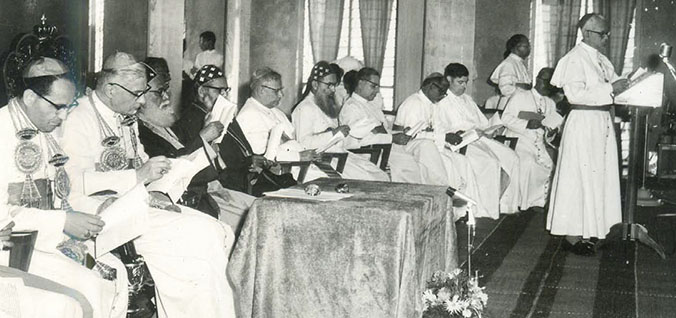
The administration of the seminary was directly under the supervision of the Syro-Malabar Bishops until the Syro-Malabar Church gets its Sui Juris stateus. SMBC appointed a commission of three bishops, with bishop Sebastian Valloppilly as the chairman of the commission. It is appropriate to place on record the names of the chairmen of the subsequent synodal commissions: Mar Antony Padiyara, Mar Joseph Pallickaparambil, Mar Jacob Thoomkuzhy, Mar Kuriakose Kunnassery and Mar Joseph Kallarangat. The present synodal commission is Mar Mathew Moolakkat, the chairman and Mar Joseph Parumthottam and Mar Thomas Chakkiath as members. The Pontifical Delegate Mar Abraham Kattumana, Major Archbishops Mar Antony Cardinal Padiyara and Mar Vrarkey Cardinal Vithayathil are also of honorable memory who took over the administration of the seminary as the heads of the Synod of the Syro-Malabar Church.
Presently, Mar George Cardinal Alamcherry, the Major Archbishop of the Syro-Malabar Church is the formal head of administration of the Seminary. The first resident rector Fr. Vanchipurackal retired from his office in 1969. Those followed him on the chair of the rector too were all industrious men and great visionaries who created the esteemed history of the seminary for half a century. This team of great formators include Mar. Joseph Pallickaparambil (1969-73), Msgr. Zacharias Vazhappilly (1973-82), Very Rev.Fr. Joseph Koikkakudy (1982-89), Very Rev.Fr. Zacharias Elippulikkat (1989-99), Very Rev. Fr. Thomas Srampickal (1999-2004), Mar. George Madathikkandam (2004-2009), Very Rev. Fr. Alex Tharamangalm (2009-14), Very Rev. Fr. Joy Ayniyadan (2014-19). Very Rev. Fr. Scaria Kanniyakonil is the present rector.